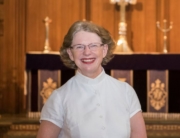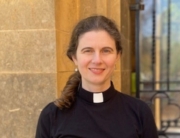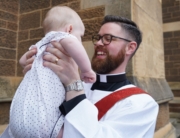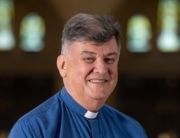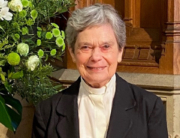A sermon given at the 10.30am Choral Eucharist by The Rev’d Canon Bill Goodes, on the 14th August 2022, the Feast of Mary, Mother of our Lord
Readings: Isaiah 61:10-62:3, Magnificat, Galatians 4:1 – 7, Luke 2:1 – 7
“When the fulness of time had come, God sent his Son, born of a woman…so that we might receive adoption as children” (Galatians 4:4)
One of the questions that Welcomers and Tour Guides are asked by our visitors is “Can men go into the Lady Chapel?” They then have to explain that “Lady Chapel” is shorthand for “The Chapel of our Lady”. By tradition that is the way the principal chapel in cathedrals or other churches is dedicated — a dedication to the Blessed Virgin Mary, who in mediaeval times was often referred to as “our Lady”. And of course the chapel of Our Lady welcomes people of all genders to pray, to worship, to be quiet, or even to enjoy the ambience. In more recent years, this dedication has been graced and focussed by the strong, Eastern-looking sculpture of our Lady fashioned by the Eastern-European artist, Voitre Marek.
There are two other three-dimensional representations of Mary the Mother of our Lord in the Cathedral, on the lowest level of the reredos screen, one on our right, with her mother, Saint Anne, and the other with her Son, the infant Jesus. Their position at the base of the intricately-designed and carved screen is interesting: the image of the glorified Christ, seated on the throne in royal robe is surrounded by countless angels, saints and gospel-writers, with just a hint at the Passion of Christ high up on the side screens. But these two figures of Mary at the base, set that whole complex of glory in the context of family relationships. so, at the base of all the glory is the domestic! Paul, in that passage from the letter to the Galatians, says the same thing about history, setting the family, “his Son, born of a woman” at the “fulness of time”, the crux or climax of history.
Mary stands in these two images, at the crossover between the Old and the New, nurtured in the traditions of God’s Old Covenant people by her mother, and in turn being the formative influence on her Son as he inaugurated God’s New Age.
Near the beginning of the Gospels of Matthew and Luke the authors set out a line of ancestry for Jesus: Matthew (1:1) begins the line with Abraham, and ends it with “Joseph the husband of Mary, of whom Jesus was born, who is called the Messiah.” He thus locates Jesus firmly in the story of the people of Abrahamic faith. Luke (3:23ff) for his part, traces Jesus’s line backwards starting with “the son (as was thought) of Joseph” and ending with “son of Adam, son of God” — his aim is clearly to anchor Jesus’ ministry in the eternal purposes of God, and as part of the whole human race.
Now apart from three references to somewhat disreputable women in Matthew’s account, all the references to parents and children in those “family trees” are men, some names better-known to readers of our Bible than are others. However, Mary’s place as God-bearer, “Mother of our Lord”, suggests that there might be another way of constructing a family tree for Jesus. For even the mostly male-dominated recording of Jewish history could not omit altogether the women who came before Mary!
When Jesus was twelve years old, he was taken to the Temple, and he caused a deal of anxiety to his mother by staying on in the Temple with the teachers, speaking, and asking them questions. We are tempted to think that his understanding and answers, which so surprised the old teachers, was due to his divine understanding — but I believe that that is to devalue the influence of his mother (and possibly his grandmother!), the one(s) who would have told him the stories of his people from his very youngest age. Mary in her turn, would have been nurtured in the stories of the People of God by her mother. Would those stories have included stories about the women as well as the men who stood as emblems of life under God’s covenant?
I wonder, for example, whether Mary was careful to include the story of Tamar (Genesis 38), who eventually persuaded her father-in-law to grant her the right to marriage that the Law provided — a fighter for justice! Perhaps there were also stories of the bloodthirsty women like Jael, the wife of Heber the Kenite (Judges 4) who destroyed one of the enemies of the people by particularly blood-thirsty means — or the later story of Judith, who acted similarly!
There would certainly been stories of Queen Esther (Esther), who put her life at risk in order to save her whole people from extermination, and so to establish the annual Feast of Purim, an important part of the Jewish calendar.
Then there was the story of the mother of seven sons, who encouraged them one by one (2 Maccabees 7) to accept death rather than to go against the Law by publicly eating pork. Her story shows her being “especially admirable and worthy of honourable memory” as with eloquent speeches she bolstered the will of her sons, so that in spite of them being offered all sorts of enticements to even pretend to obey the king’s order, they gave up the lives for the Law. And after describing each of the seven sons dying after increasing maltreatment and torture, the record concludes “Last of all, the mother died, after her sons”.
Yes, along with the stories of Abraham, Moses, Elijah, David and Solomon, would Mary not have included stories of the women who formed her “family tree” as she nurtured her Son in the traditions of her People!
But the song-line established by that process did not reach its ending in Mary: it continues to this day, and we are continuing to sing that song! She stands at the centre of the line, the bridge between old and new. The song that she sang that we call Magnificat clearly is based on the earlier song of Hannah, at the birth of her son Samuel. Then, as the book of Acts describes it, those who were gathered together as the embryo Christian community (Acts 1:12ff), names the eleven apostles, “together with certain women, including Mary the mother of Jesus, as well as his brothers”. She points both backwards and forwards along the line!
And Mary may well have wanted us to highlight the stories of the women who have continued to shine and sing along the song-line. Even in the collection of sixteen assorted saints depicted in our reredos, five of them are women. Saint Martha, sister of Mary and Lazarus of Bethany is depicted — the only one from New Testament times, then four others who died as martyrs in the third and fourth centuries: Catherine of Alexandria, beheaded by her father for practising the Christian faith, Barbara, who was martyred after torture in third-century Lebanon (as the region is now known), and Agnes, aged 12, and Margaret of Antioch, who both died in the Diocletian persecution early in the fourth century.
But there have of course been countless others. If I could misquote the letter to the Hebrews, “the time would fail me to tell of Mary Magdalene, first witness of the resurrection, Monica, mother of Saint Augustine(d.387), Hilda of Whitby, peace-maker in the English Church (680), Hildegard of Bingen, abbess and musician (1179), Clare of Assisi, companion of Saint Francis (1252), Julian of Norwich, revealer of Divine Love (1417). Or even those of more recent times, Elizabeth Fry (1845) and Frances Perry (1892), carers of the poor, Georgiana Molloy, pioneer and botanist in Western Australia (1843), Evelyn Underhill, spiritual writer (1941). Sr Emma and Mother Esther, founders of religious orders.” We might even mention Colleen Beinl and Cynthia Poulton, benefactors of this Cathedral — and each of us has our own list of shining lights!.
So, where do we stand on Mary’s song-line? What notes are we adding to its move towards its heavenly destination? Are we honouring our forebears on that line? Are we joining with Mary, the other women and the apostles, “constantly devoting themselves to prayer”? May we, with them, “tell out …the greatness of the Lord, unnumbered blessings, give my spirit voice!”

